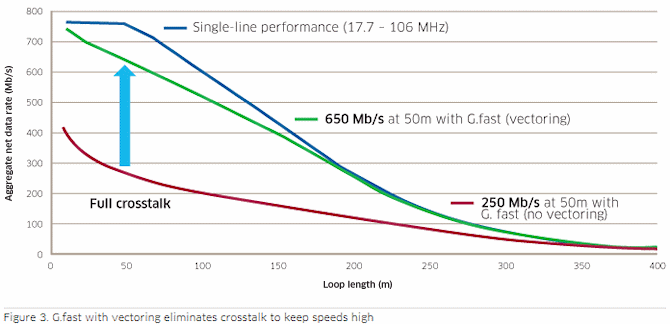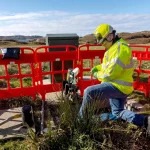Sckipio Predicts Ultrafast 1Gbps G.fast Broadband Deployments for 2015

Israel-based modem maker Sckipio has predicted that pressure from rival cable platforms could push telecoms operators like BT in the UK to begin rolling out next gen G.fast (aka – FTTC2 / ITU G.9700) broadband technology, which might deliver speeds of up to 1000Mbps over some hybrid fibre optic and copper lines, much sooner than expected.
Currently BT’s Fibre-to-the-Cabinet (FTTC) solution can deliver speeds of up to 80Mbps using 17MHz (radio frequency spectrum), which works by replacing the existing copper cable between street cabinets and your local telephone exchange with a fibre optic line. The final copper line run (between cabinets and your home) is then managed by VDSL2 technology, which is like ADSL but faster over short distances (VDSL works best at distances of below 400m but it can operate at over 1500m with much slower speeds).
Advertisement
By comparison G.fast works in a similar way to VDSL but it’s been designed for considerably shorter runs of copper cable (below 250m) and uses 17 – 106MHz (the specification allows for even higher frequencies), which means that to work at its best it needs to be moved closer to homes and this might require a Fibre to the Distribution Point (FTTdp) / Fibre to the Remote Node (FTTRN) solution (i.e. shortening the run of remaining copper lines from street cabinets by replacing part of it with fibre optic).
In theory G.fast could deliver aggregate data rates ranging from 150Mbps at 250m to 1Gbps over cable lengths of less than 100m, which would be achieved using Vectoring technology to help cancel out crosstalk (interference). Vectoring works a bit like the noise cancellation technology in some headphones and would need to be activated on all of the lines in a street cabinet in order to work properly. One of Alcatel-Lucent’s recent trials demonstrated that 650Mbps was possible at 50-100m with vectoring enabled (FTTC can also use Vectoring).

At present the G.fast standard (ITU G.9700) is still going through its final approval process and many expect this to be completed by around Q3 2014 (here), although such a significant change is likely to require extensive testing before operators can even begin to consider deployment.
But Sckipio’s CEO, Dudi Baum, believes that faster speeds from cable operators (e.g. Virgin Media’s 152Mbps package) and true fibre optic (FTTH/P/B) providers could force some operators to fast-track the service into deployment (albeit only on a limited scale at first), possibly as soon as 2015. Baum said that they will provide the first samples of their new g.fast based modem chips “in a few months“.
Advertisement
In fairness Sckipio is an active member of the G.fast ITU study group and claims to have provided “over 20% of all the contributions” to the standards recommendation, which means that it’s in their interest to be optimistic; perhaps overly so. On the other hand BT, like many other operators, have already confirmed the first Huawei-based trials of G.fast at its Adastral Park R&D facility near Ipswich in Suffolk (here) and they’ve been lab testing it for quite a while before. FTTdp/RN trials are also on the way and Vectoring is already being tested in the wild.
The technology sounds like an effective solution but there are more than a few complex hurdles to overcome along the way. For example, VDSL2 and G.fast might use different spectrum to stay apart but they also use different signal duplexing schemes and this difference would make it difficult to use Vectoring technology to iron out interference (crucial for g.fast) in environments where VDSL2 and G.fast need to co-exist (e.g. BT’s network).
Various other complications also exist, such as conflicts with the kit used by Sub-Loop Unbundled (SLU) providers (arguably less of a problem now that Digital Region has kicked the bucket), a costly deployment (it might be less costly than FTTH/P but g.fast and FTTdp would by no means be cheap), a time consuming roll-out (several years – depending upon coverage targets) and the introduction of greater complexity in the management of BT’s network.
G.fast also uses a “parasitical power” setup, which means that it’s designed to work without mains power by drawing current from the customers own modem or router device (this would also benefit FTTdp/RN deployments). This might make some people nervous but it’s still a fairly low-power consumption and the cost / regulatory savings that BT would make here (not having to contract and build dedicated power supplies for each local node) would make this aspect easier to deploy.
Advertisement
So a late 2015 introduction might not be impossible for some countries but it seems unlikely for the UK, where G.fast and FTTdp/RN are only just entering the very earliest of trial phases and Vectoring has yet to extend its existing trial into more areas.
BT will want to deploy Vectoring first, assuming they do go ahead with it (they’ve been very quiet since the end of last year), in order to improve their existing FTTC speeds and that will take time to complete. G.fast is likely to be last on the list so, once all is said and done, 2017 might not be an unreasonable target for the UK and that’s assuming the eventual field trials are successful.
Mark is a professional technology writer, IT consultant and computer engineer from Dorset (England), he also founded ISPreview in 1999 and enjoys analysing the latest telecoms and broadband developments. Find me on X (Twitter), Mastodon, Facebook, BlueSky, Threads.net and Linkedin.
« EE UK Offers 6 Months Half Price Unlimited FTTC Home Broadband






















































Comments are closed